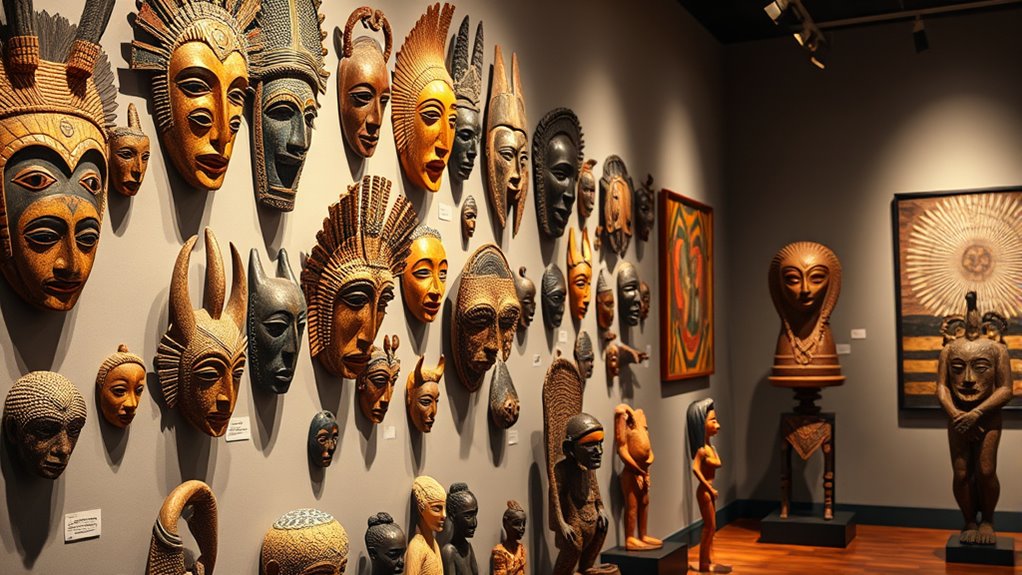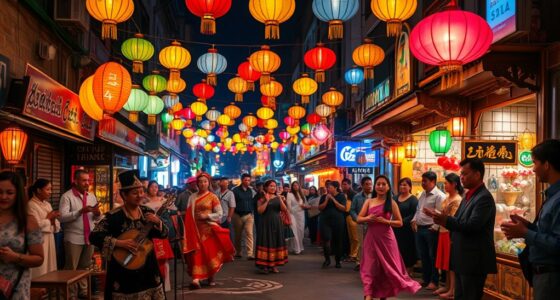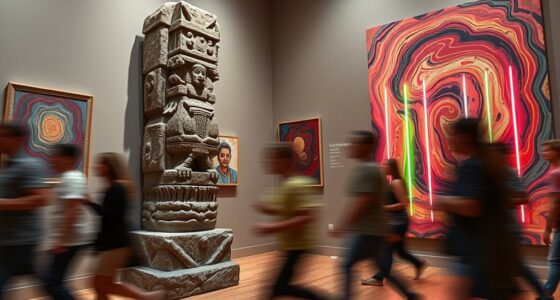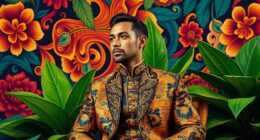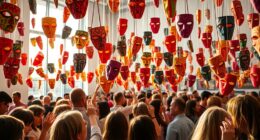African tribal art influences modern Western artists by inspiring new styles focused on abstraction, symbolism, and human forms. Artists like Picasso and Matisse drew on masks and sculptures to challenge traditional realism, emphasizing geometric shapes and spiritual meaning. These influences helped reshape modern art movements such as Cubism and Primitivism. If you explore further, you’ll discover how deeply these cultural exchanges continue to shape contemporary art and visual culture today.
Key Takeaways
- African masks and sculptures introduced abstraction, geometric forms, and stylized human features to modern Western art.
- The emphasis on spiritual symbolism and ritual significance inspired symbolic storytelling in modern artworks.
- Artists like Picasso and Modigliani incorporated African mask aesthetics, influencing Cubism and elongated forms.
- African art’s bold patterns and simplified surfaces encouraged experimental approaches to space and perspective.
- The appreciation of primal, authentic aesthetics challenged Western realism, fostering new artistic vocabularies and abstraction.
Early Encounters With African Art and Artistic Inspiration
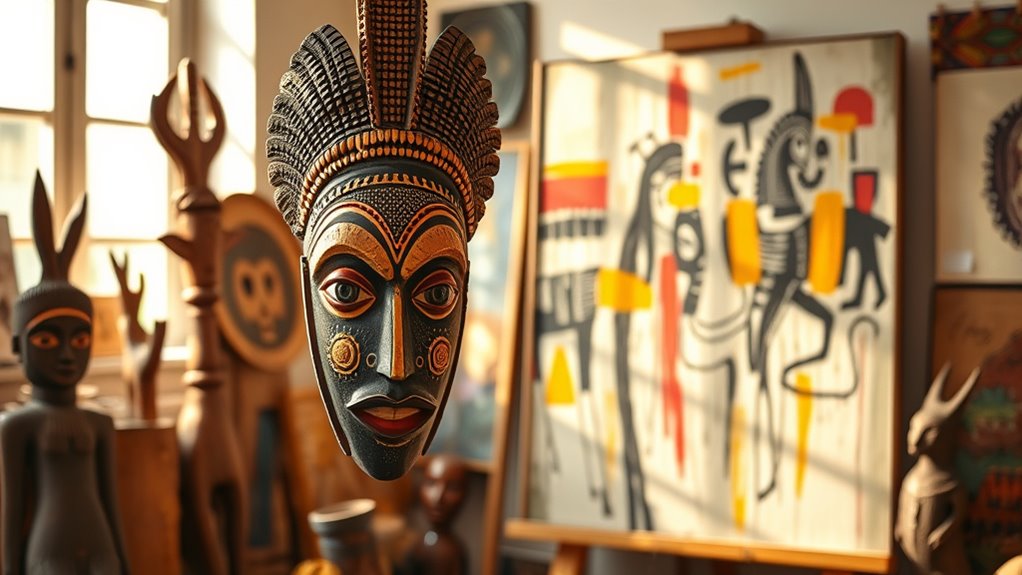
The earliest European encounters with African art began in the late 1400s when Portuguese explorers established trade routes along West Africa. You can see how these interactions influenced artistic exchange, with African artists incorporating images of Portuguese explorers—bearded men with hats—into masks and sculptures. The Portuguese also sought African ivory, called “white gold,” inspiring new artworks centered around this prized commodity. West African carvers created ornate saltcellars for Portuguese officers, blending local styles with European influences. Trade items like guns and European goods became symbols within African art, reflecting cross-cultural exchanges. These early encounters marked the start of a dynamic artistic dialogue, shaping African art’s evolution while serving as visual records of contact between two worlds. European contact introduced guns, Christianity, and European goods, which further influenced the development and themes of African art during this period. Additionally, the exchange of artistic motifs helped to forge new aesthetic traditions and expand artistic vocabularies across cultures.
Key Artists and Their African-Inspired Works
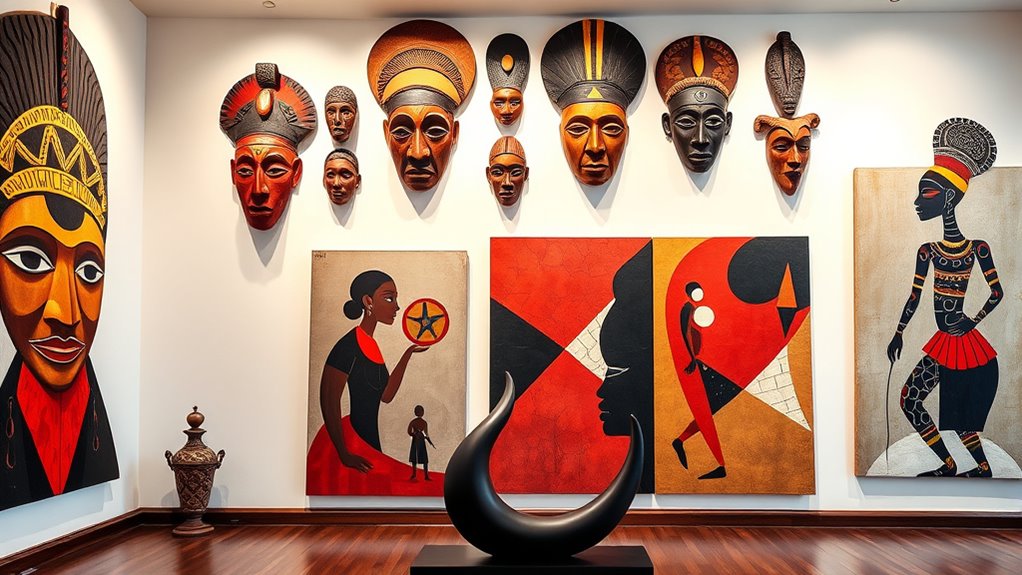
You can see how Picasso’s use of African mask shapes transformed his cubist style, especially in works like “Les Demoiselles d’Avignon.” Similarly, Modigliani’s sculptures and paintings feature elongated forms that echo African mask aesthetics. These artists directly drew from African art to push modern Western art into new, abstract directions. African sculptures’ emphasis on abstraction and stylized features played a crucial role in shaping their innovative approaches. This influence underscores the significance of Impact of Natural Language Processing (NLP) on Customer Experience in inspiring creativity and cultural exchange.
Picasso’s Mask Influence
How did African masks shape Picasso’s artistic evolution during his African Period? When Henri Matisse introduced him to masks from the Dan region, it sparked a transformative phase in his work. Between 1907 and 1909, Picasso’s style shifted, emphasizing abstracted forms and earthy tones. He saw masks as more than decorative objects—they held spiritual and magical significance, inspiring him to explore art as a form of magic and symbolism. This influence is evident in works like “Les Demoiselles d’Avignon,” where mask-like faces challenge traditional portraiture. In “Nude, Green Leaves and Bust” and “The Weeping Woman,” African motifs become central, highlighting how masks shaped his approach to form and expression. These influences fueled his move toward Cubism and changed modern art’s trajectory. The masks’ spiritual significance is a key factor in understanding Picasso’s shift toward abstraction and symbolism during this period. Additionally, the use of cultural symbolism helped artists like Picasso connect their work to broader spiritual and mystical traditions, further enriching their artistic language. Recognizing the artistic inspiration behind Picasso’s work reveals how deeply interconnected cultural artifacts and modern art can be. Furthermore, the study of tribal art provides insight into how non-Western traditions expanded the boundaries of contemporary artistic expression. Moreover, understanding the artistic exchange between cultures highlights the global influences that shaped early 20th-century avant-garde movements. Exploring these connections demonstrates how cross-cultural interactions continue to influence contemporary art practices today.
Modigliani’s Elongated Forms
African masks, especially Baule masks with their distinctive elongated faces, profoundly influenced Amedeo Modigliani’s artistic style. You can see this impact in his portraits and figures, where elongated faces and necks become a signature feature. His exposure to African art at the Trocadero Museum in Paris exposed him to stylized forms that broke away from European realism. This cross-cultural influence sparked aesthetic innovations, such as:
- Simplified, elongated shapes that emphasize emotion
- Bold, abstract features inspired by tribal masks
- A focus on spiritual and symbolic qualities over naturalistic detail
These elements helped shape modernist movements and continue to inform contemporary art. Modigliani’s African-inspired elongation remains a powerful example of how tribal aesthetics transformed Western figurative art. The influence of African art on Modigliani helped foster a new visual language that challenged traditional European standards of beauty and realism, highlighting the importance of cultural exchange in artistic development.
Characteristics of African Art Adopted by Modernists

Modernist artists drew inspiration from the key characteristics of African art, adopting its emphasis on abstraction and geometric simplification to break away from traditional Western realism. You’ll notice how they used abstract shapes—rectangles, triangles, and circles—to fragment forms and create a new visual language. Simplifying complex figures into essential shapes allowed them to focus on symbolic meaning rather than precise anatomy. African masks and sculptures, with their flat planes and faceted surfaces, influenced Cubist techniques that depict multiple perspectives simultaneously. You’ll also see how the symbolic distortion in African art, emphasizing spiritual and cultural narratives, encouraged modernists to embed deeper meanings into their work. African art’s emphasis on abstraction and symbolism further shaped modern design and composition, emphasizing rhythm and visual flow. Strong lines and repetitive patterns further shaped modern design and composition, emphasizing rhythm and visual flow.
The Cultural and Spiritual Significance of African Masks
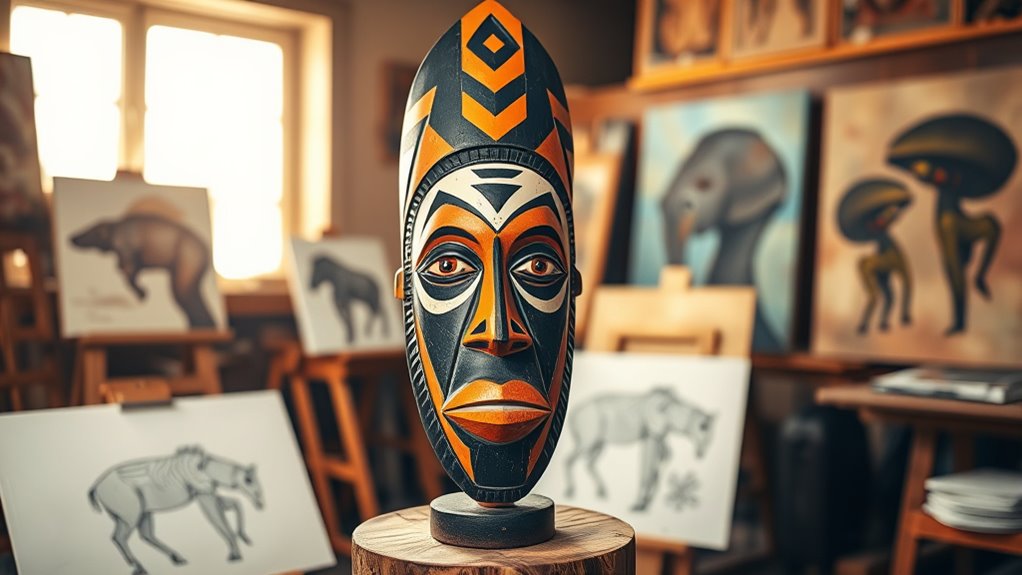
Masks play an essential role in many African communities by serving as powerful symbols that connect the physical and spiritual worlds. They are used in ceremonies like harvest festivals, funerals, and rites of passage to honor ancestors and deities. Masks also help mediate conflicts, restore social harmony, and provide spiritual guidance during uncertain times. They embody spirits, depict myths, and symbolize important values such as bravery and wisdom. Many masks mark social status or clan affiliation, reinforcing cultural identity. Key aspects include:
Masks connect communities with spirits, honor ancestors, and symbolize cultural values through ceremonies and social roles.
- Serving as conduits between the living and spiritual domains
- Representing spirits, ancestors, or deities
- Symbolizing community values and social roles
Through these functions, masks maintain spiritual bonds, uphold traditions, and foster communal cohesion. Cultivating Cultural Intelligence enables communities to preserve these meaningful traditions and ensures respectful cultural exchange. Recognizing the symbolic significance of masks deepens our understanding of their role in cultural identity and spiritual practice. Additionally, the craftsmanship involved in creating masks often reflects intricate artistic techniques, highlighting the skill and dedication of artisans. Understanding the cultural context behind mask creation further enriches appreciation for their enduring importance.
African Primitivism and the Development of Primitivist Movements

Primitivism emerged in the late 19th century as Western artists sought inspiration beyond traditional European styles, and African tribal art played an essential role in shaping this movement. The 1878 opening of the Trocadéro Museum in Paris exposed African tribal art to the public for the first time, sparking curiosity among modern artists. Many visited the museum, collecting African and Oceanic artworks to incorporate their aesthetics into their own practices. Primitivism wasn’t a formal style but a broad trend among artists keen to explore perceived authenticity and simplicity outside Western conventions. Influenced by African masks, sculptures, and spiritual symbols, artists like Gauguin, Picasso, and Matisse integrated these elements into their work. This movement critically challenged European art norms and laid groundwork for Modernism’s avant-garde experiments. African tribal art profoundly impacted the development of modern art by inspiring innovative approaches to form and symbolism, as artists sought to incorporate authentic cultural expressions into their creative vocabularies. Additionally, the movement emphasized a fascination with primitive aesthetics, which further inspired experimentation with raw and unrefined visual language. Moreover, the increased availability of ethnographic collections during this period facilitated artists’ access to diverse tribal artworks, fueling their creative exploration. The exposure to such artistic diversity also encouraged a breaking away from traditional European artistic standards, fostering experimentation and innovation.
Impact on Artistic Techniques and Styles in Modernism
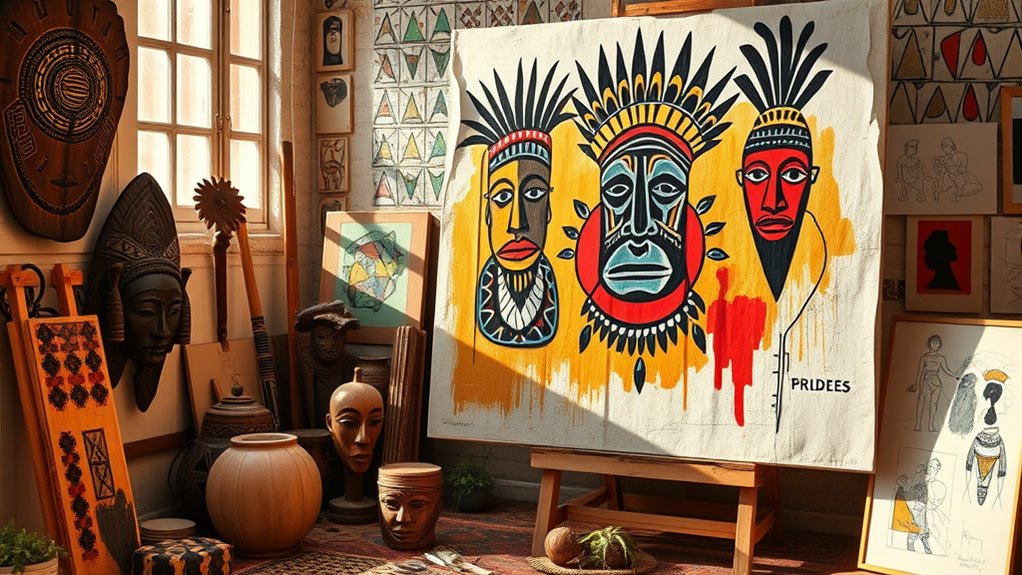
African tribal art profoundly influenced the development of modernist techniques and styles by inspiring Western artists to explore abstraction, geometry, and new ways of representing the human form. You’ll notice a shift from realistic depictions to flattened, angular shapes, often inspired by African masks and sculptures. Artists like Picasso and Braque incorporated mask-like features and simplified structures into their Cubist works. This influence led to:
African tribal art inspired modernist abstraction, bold geometry, and mask-like forms in Western painting.
- Use of stylized, abstracted human and animal forms
- Emphasis on line and form over detailed realism
- Bold, geometric shapes and exaggerated features in portraits
You’ll also see vibrant, contrasting colors and rhythmic patterns, reflecting African textiles and body art. These innovations challenged traditional perspectives, encouraging experimentation with space, multiple viewpoints, and layered compositions, shaping the essence of modernist art. Additionally, the incorporation of visual harmony and rhythm from African art contributed to the dynamic energy and movement seen in modernist compositions. This cross-cultural exchange underscored the importance of cultural symbolism in inspiring innovative artistic expressions. Modernist artists also drew inspiration from traditional motifs, which further enriched their creative vocabularies. The appreciation of artistic motifs from African traditions further enriched the vocabulary of modernist artists, leading to a deeper exploration of cultural identity in their work.
African Art’s Role in Challenging Western Artistic Norms
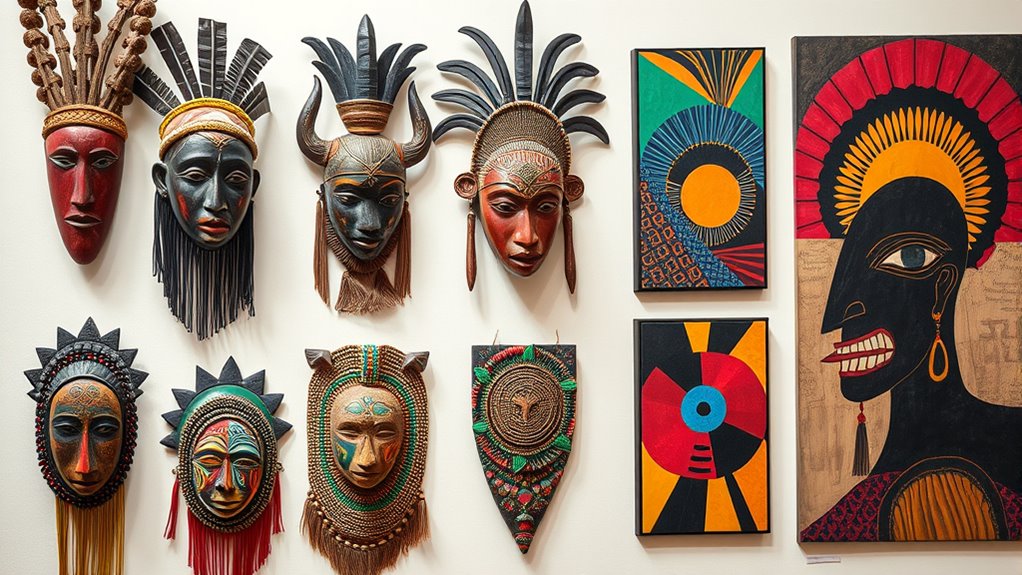
The influence of African tribal art extended beyond inspiration to challenge and reshape Western artistic norms. You discover how African art introduced bold abstraction and stylized forms, pushing artists to move away from strict realism. Masks and sculptures with non-naturalistic depictions prompted experimentation with unconventional representations of the human body. The flat, two-dimensional compositions of African artworks influenced Western artists to embrace surface simplicity and symbolic storytelling. This broadened the definition of beauty, shifting focus from classical ideals to diverse expressions. Artists like Picasso, Matisse, and Kirchner drew from African aesthetics to develop new styles, challenging traditional standards. African art’s emphasis on symbolism, abstraction, and spiritual significance fundamentally questioned Western notions of aesthetics, fostering innovative perspectives that still resonate today.
Contemporary Influence and Ongoing Cultural Dialogue
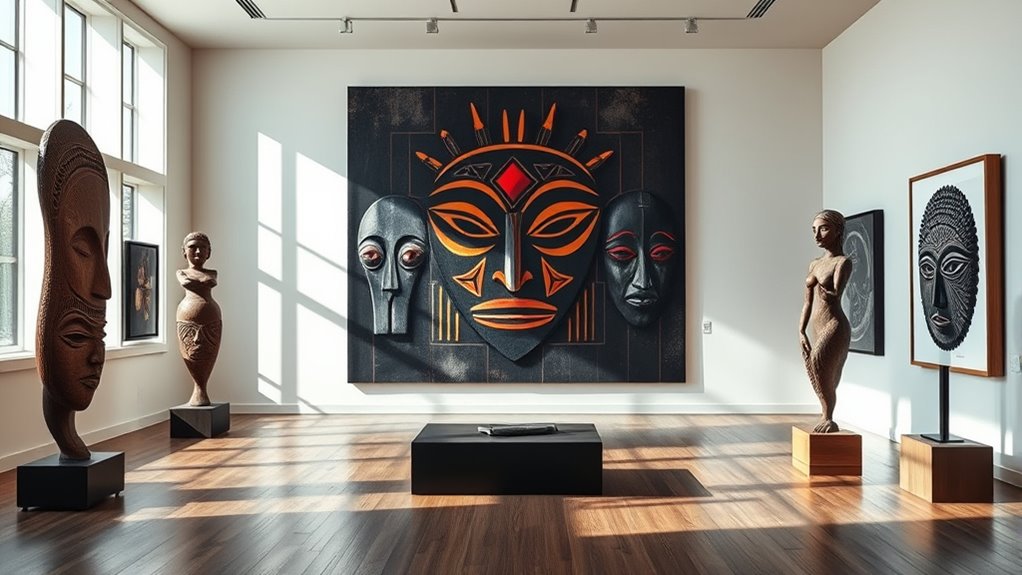
Contemporary Western artists continue to draw inspiration from African tribal art, integrating its bold abstraction, vibrant colors, and symbolic motifs into their work. This ongoing influence fosters a lively cultural dialogue, enriched through collaborations, exhibitions, and digital reinterpretations. You’ll notice African-inspired elements like mask motifs, geometric patterns, and storytelling methods appearing across various mediums, from street art to multimedia installations. These exchanges:
- Strengthen cross-cultural collaborations and residencies.
- Promote African diaspora artists’ engagement with heritage.
- Use digital platforms to reinterpret African motifs and ideas.
This dialogue challenges Western art norms, inspiring innovation and diversification. Major museums now showcase African art as a crucial part of modern art history, emphasizing its evolving role. As a result, African aesthetics continue to shape themes of identity, postcolonial discourse, and stylistic boundaries in contemporary art.
Frequently Asked Questions
How Did African Art Influence the Development of Cubism?
You see, African art influenced Cubism by inspiring artists to break traditional rules. They adopted African sculptures’ geometric shapes, abstract forms, and multiple viewpoints, challenging realistic perspective. Picasso, for example, was inspired by masks and carvings, which led to fragmented, layered compositions. This shift prioritized emotion and inner vision over realism, revolutionizing modern art and encouraging experimentation beyond classical techniques.
In What Ways Did African Masks Symbolize Spiritual Beliefs in Modern Art?
You see that African masks symbolize spiritual beliefs by serving as vessels for spirits and ancestors, connecting the physical and spiritual worlds. They embody cultural heritage, depict deities, and are used in rituals to communicate with ancestral spirits. Modern artists incorporate these themes, using masks’ symbolic and spiritual elements to explore ancestral influence and cultural narratives, enriching contemporary art with deep, meaningful connections to spirituality and tradition.
Why Did Western Artists Seek “Primitiveness” in African Art Forms?
Imagine you’re searching for fresh ideas, like explorers seeking new lands. Western artists sought “primitiveness” in African art because it offered raw, authentic expression, free from academic constraints. They admired its simplicity, boldness, and spiritual depth, much like discovering unspoiled treasures. This “primitiveness” challenged traditional Western techniques, inspiring innovation and a desire to break free from conventional norms, fueling modern art’s evolution.
How Does African Tribal Art Challenge Traditional Western Notions of Beauty?
You see, African tribal art challenges Western ideas of beauty by emphasizing symbolic meaning, spirituality, and bold forms over realistic representation. Instead of focusing on proportion or naturalism, it highlights abstract shapes and vibrant colors that evoke emotional and spiritual depth. This shifts your perspective, encouraging you to appreciate beauty beyond conventional standards, and opens your eyes to the diverse ways cultures express identity and meaning through art.
What Is the Significance of African Art in Contemporary Global Art Movements?
Think of African art as a vibrant river that flows into the ocean of contemporary global art movements, shaping new currents. You see, it sparks innovation by inspiring bold geometric shapes, vivid colors, and symbolic storytelling. This cross-cultural exchange breaks down boundaries, encouraging artists like you to explore deeper meanings, challenge traditions, and create more inclusive, dynamic art. Its influence continues to fuel the evolution of global artistic expression today.
Conclusion
As you explore the vivid tapestry of African tribal art woven into Western creativity, you see how bold masks and striking patterns ignite your imagination. Their raw energy and spiritual depth challenge your perceptions, inviting you to embrace a world beyond traditional boundaries. This ongoing dialogue transforms your understanding, blending ancient symbols with modern expression—creating a vibrant mosaic where cultures collide and inspire, forever expanding your artistic horizon with every stroke and sculpture.

